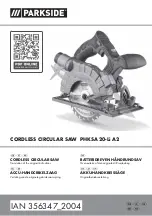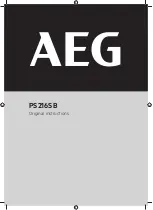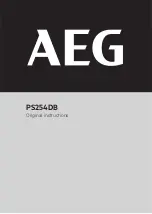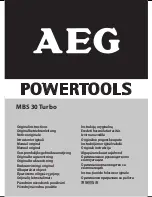
30
GB
Wipe chips and dust off the machine from time to
time using a cloth. In order to extend the service life
of the tool, oil the rotary parts once monthly. Do not
oil the motor.
When cleaning the plastic do not use corrosive prod -
uct.
Cleaning
• Keep all safety devices, air vents and the motor
housing free of dirt and dust as far as possible.
Wipe the equipment with a clean cloth or blow it
with compressed air at low pressure.
• We recommend that you clean the device immedi-
ately each time you have finished using it.
• Clean the equipment regularly with a moist cloth
and some soft soap. Do not use cleaning agents or
solvents; these could attack the plastic parts of the
equipment. Ensure that no water can seep into the
device. The ingress of water into an electric tool i
creases the risk of an electric shock.
Maintenance
There are no parts inside the equipment which re-
quire additional maintenance.
12. Storage
Store the device and its accessories in a dark, dry
and frost-proof place that is inaccessible to children.
The optimum storage temperature is between 5 and
30˚C.
Cover the electrical tool in order to protect it from
dust and moisture.
Store the operating manual with the electrical tool.
13. Electrical Connection
The installed electric motor is connected and is ready
to work.
The connection complies with the relevant VDE and
DIN regulations.
The customer-side mains supply and the used exten-
sion line must meet these regulations.
Important information
In the event of an overloading the motor will switch
itself off. After a cool-down period (time varies) the
motor can be switched back on again.
Defective Electric Connection Lines
Often, insulation damages occur on electrical con-
nection lines.
Causes are:
• Drag marks if connection lines are led through win-
dow or door clearances.
• Kinks due to improper attachment or routing of the
connection line.
• Cuts caused by running over the connection line.
• Insulation damages caused by pulling the connec-
tion line out of the wall socket.
• Fissures caused by the ageing of the insulation.
Such defective electric connection lines must not be
used and are hazardous due to the insulation dam-
ages.
Regularly check the electrical connection lines for
damages. Please make sure that the connection
lines are disconnected from the mains supply during
the check.
Electrical connection lines must comply with the rel-
evant VDE and DIN regulations. Only use connection
lines labelled with H05VV-F. The labelling of the con-
nection cable with the type specification is required.
AC motor
• The mains voltage must be 220 - 240 V~
• Extension cables up to 25 m long must have a
cross-section of 1.5 mm
2
.
Connections and repairs of electrical equipment may
only be carried out by an electrician.
Please provide the following information in the event
of any enquiries:
• Type of current for the motor
• Machine data - type plate
• Machine data - type plate
14. Disposal and recycling
The equipment is supplied in packaging to preven it
from being damaged in transit. The raw materials in
this packaging can be reused or recycled. The equip-
ment and its accessories are made of various types
of material, such as metal and plastic. Defective
components must be disposed of as special waste.
Ask your dealer or your local council.
Old devices must not be disposed of with
household waste!
This symbol indicates that this product must
not be disposed of together with domestic
waste in compliance with the Directive
(2012/19/EU) pertaining to waste electrical
and electronic equipment (WEEE). This product must
be disposed of at a designated collection point. This
can occur, for example, by handing it in at an author-
ised collecting point for the recycling of waste elec-
trical and electronic equipment. Improper handling
of waste equipment may have negative consequenc-
es for the environment and human health due to po-
tentially hazardous substances that are often con-
tained in electrical and electronic equipment. By
properly disposing of this product, you are also con-
tributing to the effective use of natural resources.
You can obtain information on collection points for
waste equipment from your municipal administration,
public waste disposal authority, an authorised body
for the disposal of waste electrical and electronic
equipment or your waste disposal company.
Содержание 5901505850
Страница 2: ......
Страница 5: ...Fig 9 1 Fig 9 1 Fig 10 Fig 8 1 Fig 9 Fig 11 k o M L Q 8 N J 11 Fig 7 3 Fig 7 4 Fig 8 P k 5 d...
Страница 7: ...Fig 15 Fig 16 Fig 17 e e Fig 18 g f g e g f g e h h i i j R o m l 14 n k...
Страница 8: ...Fig A Fig B Fig D Fig C...
Страница 45: ...45 R1 R2 C K2 K2 K1 S 230 240V A10...
Страница 46: ...46...
















































